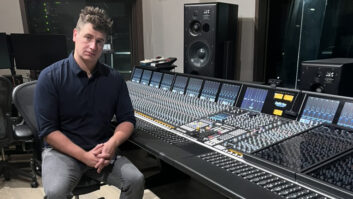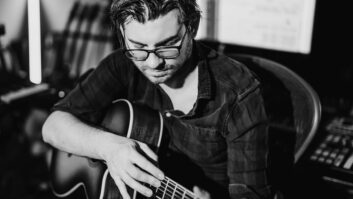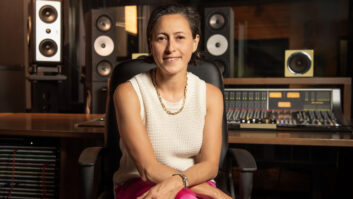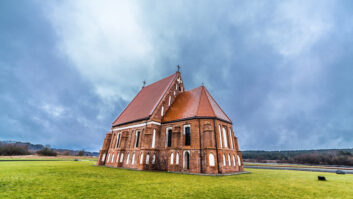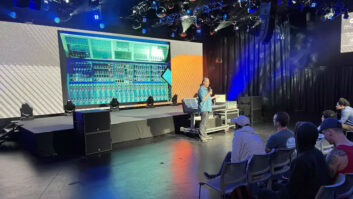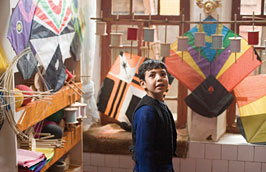
Photo: Phil Bray
Khaled Hosseini’s novel The Kite Runner was a huge best-seller when it came out in 2004, but there was no guarantee that it could successfully be made into a film. Even with a proven director at the helm — Marc Forster, of Monster’s Ball, Finding Neverland and Stranger Than Fiction — the story of an Afghani boy’s return to his native land, since taken over by the Taliban, to help an old friend, didn’t exactly scream “blockbuster.” Throw in the fact that the film features a cast of foreign unknowns, is largely in languages other than English, and has a grim sexual assault of a child as one of its key plot-points, and it’s easy to see why movie producers might have viewed it as a risky project, and why ultimately it was made more on an indie budget than a major studio outlay. Still, director Forster managed to attract a top-notch sound crew to work on the film, and even though everyone involved had to dig deep to be creative within certain financial restraints, the result is a film that is being acclaimed for its power, sensitivity and artfulness.
Spearheading the post sound team at Skywalker Sound in Marin County, Calif., was supervisor Frank Eulner (Hellboy, The Village, Charlotte’s Web), who was joined by sound designer Steve Boeddeker (X-Men, Charlie and the Chocolate Factory, Corpse Bride), re-recording mixers Michael Semanick (two-time Oscar winner for The Lord of the Rings: Return of the King and King Kong; Ratatouille) and Lora Hirschberg (Batman Begins, The Prestige, Into the Wild). When I spoke with Boeddeker and Semanick, they had just completed work on Sweeney Todd (and Semanick also worked on There Will Be Blood), so they’ve been very busy fellows of late.
Now, it’s common on big-budget films for the sound supervisor and/or principal sound designer and their crew to spend weeks or even months out in the field recording both hard effects and various raw material elements that can be used for backgrounds or combined in interesting ways to create original FX. We’ve all read many a story about painstaking sessions recording specific guns or cars or dogs, or traveling to exotic locales to capture “correct” ambiences. In the case of The Kite Runner, however, Eulner and Boeddeker took a different — and more economical — approach to collecting much of the material they needed to convey the sound of Afghanistan over a three-decade period. (Actually filming in Afghanistan was out of the question, so various locations in China, just over the border from Afghanistan, were used instead.)
“What we ended up doing, which worked out amazingly well,” Boeddeker relates, “was we hooked up with two documentary filmmakers, one of whom had done a documentary about Afghanistan, among other places, in the ’70s and ’80s, and another who had just recently been there. We made a deal with them where we said, ‘Okay, we’re going to go through all your material — all your sound recordings, all of your DV videocam stuff; anything that had sound on it, and see what we can use.’ So I would go through it, clean it, make it into a library, and we then paid them for the right to use it and gave them their library back. It was amazing how much we learned about Afghanistan by going through all this material, and it solved one our big problems going in, which was how do we get authentic-sounding Afghani backgrounds and exteriors and cars and such that are appropriate for the period?” The two documentaries in question were Shadow of Afghanistan by Jim Burroughs, Suzanne Bauman and Dan Devaney, and Beyond the Call by Adria Belic.

Photo: Phil Bray
“Marc [Forster] wanted it to sound as accurate as possible, as if it was a documentary, but not sound like a documentary,” Boeddeker says. “It’s like a Hollywood version of a very accurate documentary-type sound. So that’s what we were doing when it came time to temp. And that was great — it was just right. Then we said, ‘Let’s go back and look at it from an overall emotional story standpoint and work on some sound design things.’”
Such as? “We started doing things like taking some of [main character] Amir’s memories and, if it was a positive memory we’d heighten the positive side of it with sound, and if it was potentially a negative memory we made it sound worse. For instance, when they first go back [in a flashback] to Afghanistan, when everything’s happy, you don’t see birds, but we filled the courtyard with tons of birds and you can hear people in the distance and there’s laughing and kids singing; a lot of positive type of things and good home feelings. Then, when he goes back years later, [the capital city of] Kabul’s been completely destroyed, and the sound is very stark and quiet. There are no birds. It turns out the Taliban actually did go in and chop down a bunch of trees, so it’s a legitimate sound choice, as well. But there’s no laughing. And we put in occasional distant gunfire which ended up being very effective. It’s from one of the documentaries, so it’s real stuff. The [documentary filmmakers] had also recorded some guys listening to a Taliban battle over the radio, so we ended up putting that in a scene, too — it’s on in the background. You hear this yelling and screaming and gunfire and explosions; it’s very strange.”
“Steve and Frank did a great job of bringing me a lot of different tracks to layer,” adds Semanick, who mixed the show on a Neve DFC. “A lot of what came to me from the documentaries were stereo tracks they had prepped up, and there were also some mono tracks, so I could place this one slightly left, that one slightly right, so it’s not just a stereo background; it has a little more depth. Like when the kids run through the marketplace in Kabul in ’69, what Marc Forster stressed is that he really wanted it to be a lively, active place; a fun place to grow up in. So we’d have all these great sounds coming from all over — someone’s making something over here, someone’s yelling over there, and I’d move it all around the room [using the surrounds].”
Semanick says director Forster “is a great one for letting you run with it. He has specific ideas, of course, but he also gives you the opportunity to take it and be creative — sort of, ‘Show me something so that that I feel the emotion of this scene.’”
As often as not, it was the unexpected choices of what sounds to emphasize and the subtle application of processing that carried many of the film’s most effective sound moments. Semanick cites a scene in which our protagonists are trying to escape to America by traveling in a milk tanker, “and it’s almost completely dark and the sound is all the rumbling of the truck and the eerie tones inside there, the reverb of the inside of this truck, which creates this uneasy feeling of being trapped inside.”
Also challenging was the controversial rape scene, which is just a minute long, but pivotal to the emotional core of the story. “That’s pretty much all sound design and effects at the start,” Semanick notes. “There’s some close-up shots, and a kid starts beating him up, and it cuts back and forth, and it happens down an alleyway — it all becomes sort of ethereal, so I started to reverb a lot of the sounds, like the belt buckle coming undone and those sorts of things. There are lots of little sound design things going on that are sort of spooky and make you feel uneasy and help establish tension. Then the music comes in, too, and at times it’s hard to distinguish the sound effects from the music, which I think is part of the beauty of that scene.”
As for the kites of the title — kite flying (and kite fighting) being a popular pastime in Afghanistan and among Afghanis in America — they did require some special recordings by Boeddeker and Eulner. The duo each brought Sound Devices 722 recorders to a windy spot near the marina in Berkeley, Calif., and then had a kite-flying specialist from L.A. named Basir Beria demonstrate some of the amazing things that can be done with kites. (The marina area is the site of a popular annual kite festival, which draws thousands of spectators.)
“The weather wasn’t particularly good that day,” Boeddeker recalls, “and really, I wanted to record them mostly as a reference, because it’s a pretty noisy place — there’s traffic, harbor bells, planes and you name it. So Basir would fly the kite and Frank and I just stood next to him, getting all these fly-bys. I was even recording mono instead of stereo, because I didn’t think this was going to be our only shot at doing the kites — I thought we were going to get mics and try and attach them to the kites and do all this other kind of stuff another time. But when we got back to Skywalker Sound, we discovered that what we’d recorded standing right next to him had this amazing jets-by phase-y kind of thing; I’m not even sure exactly what caused it. I ended up taking all those recordings and using every kind of clean-up tool I could come up with — like the Waves restoration stuff — and crazy amounts of EQ’ing and gating to get all the traffic out of these bys, and I ended up making a huge library of kite sounds. If you were to listen to them closely, on a couple of them you can catch a little bit of train [sound] on there.” Later, some more kite recordings were made out at Skywalker Ranch, and some of the kite material was enhanced with Foley, but those original Berkeley recordings became the base sound for the kite scenes.
Semanick notes, “We pieced a lot of kite sounds together trying to give character to each kite so it’s not just a single sound all the time. Kites actually make a very cool and interesting sound when they whish by you. I didn’t have to do a whole lot to the recordings because they sounded so good, but I did a lot with the movement of the kite, panning it left and right and sort of whipping it across the screen. There are also a lot of shots with [the characters] on the ground where they’re looking up at the kites, but you’re looking at [the people], so I got to pan the kites a lot in the surrounds. [A kite flyer would] pull, and you’d see him look to the left, so in the left surround you hear the kite whip. That was fun to do because it gave the whole scene more character.”

